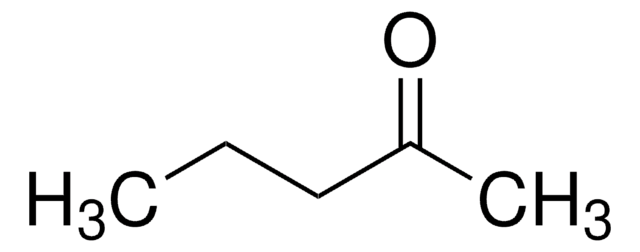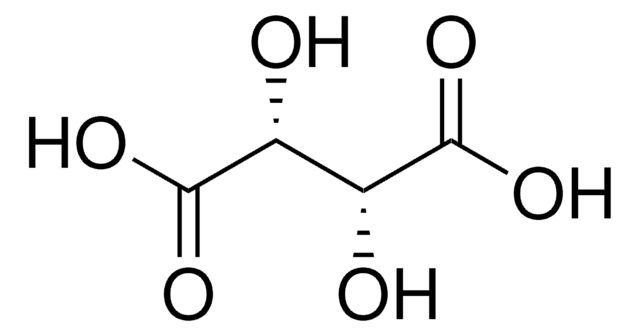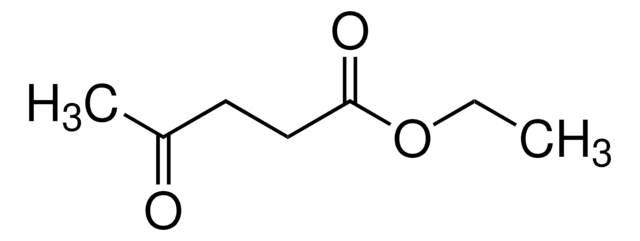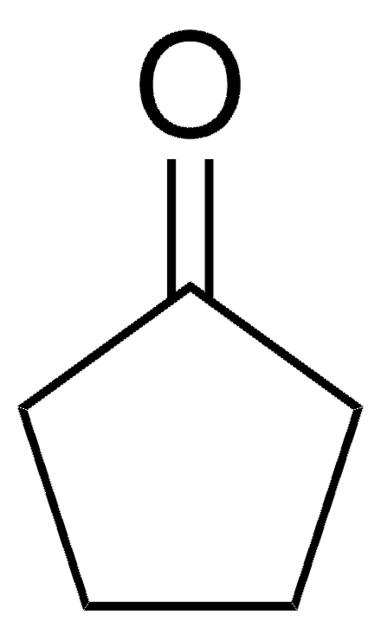W390909
Cyclohexanone
99.8%
Sinónimos:
Hexanon, Keto hexamethylene, Ketohexamethylene, Pimelic ketone, Sextone
About This Item
Productos recomendados
origen biológico
synthetic
Nivel de calidad
Agency
meets purity specifications of JECFA
densidad de vapor
3.4 (vs air)
presión de vapor
3.4 mmHg ( 20 °C)
Análisis
99.8%
formulario
liquid
temp. de autoignición
788 °F
lim. expl.
1.1 %, 100 °F
9.4 %
índice de refracción
n20/D 1.450 (lit.)
bp
155 °C (lit.)
mp
−47 °C (lit.)
densidad
0.947 g/mL at 25 °C (lit.)
aplicaciones
flavors and fragrances
Documentación
see Safety & Documentation for available documents
alérgeno alimentario
no known allergens
Organoléptico
minty
cadena SMILES
O=C1CCCCC1
InChI
1S/C6H10O/c7-6-4-2-1-3-5-6/h1-5H2
Clave InChI
JHIVVAPYMSGYDF-UHFFFAOYSA-N
¿Está buscando productos similares? Visita Guía de comparación de productos
Descripción general
Aplicación
- Structural Revision of Hyperibrin B and Hyperscabrones H and I by Biosynthetic Considerations, NMR Analysis, and Chemical Synthesis.: Cyclohexanone is utilized in the synthesis and structural revision of complex natural products, demonstrating its utility in biochemical research (Wang et al., 2021).
- Biocatalytic conversion of cycloalkanes to lactones using an in-vivo cascade in Pseudomonas taiwanensis VLB120.: This study highlights the biocatalytic potential of Cyclohexanone in producing valuable lactones, contributing to advancements in green chemistry (Karande et al., 2018).
Cláusula de descargo de responsabilidad
Palabra de señalización
Danger
Frases de peligro
Clasificaciones de peligro
Acute Tox. 4 Dermal - Acute Tox. 4 Inhalation - Acute Tox. 4 Oral - Eye Dam. 1 - Flam. Liq. 3 - Skin Irrit. 2 - STOT SE 3
Órganos de actuación
Respiratory system
Código de clase de almacenamiento
3 - Flammable liquids
Clase de riesgo para el agua (WGK)
WGK 1
Punto de inflamabilidad (°F)
111.2 °F - closed cup
Punto de inflamabilidad (°C)
44 °C - closed cup
Equipo de protección personal
Eyeshields, Faceshields, Gloves, type ABEK (EN14387) respirator filter
Elija entre una de las versiones más recientes:
¿Ya tiene este producto?
Encuentre la documentación para los productos que ha comprado recientemente en la Biblioteca de documentos.
Los clientes también vieron
Nuestro equipo de científicos tiene experiencia en todas las áreas de investigación: Ciencias de la vida, Ciencia de los materiales, Síntesis química, Cromatografía, Analítica y muchas otras.
Póngase en contacto con el Servicio técnico













